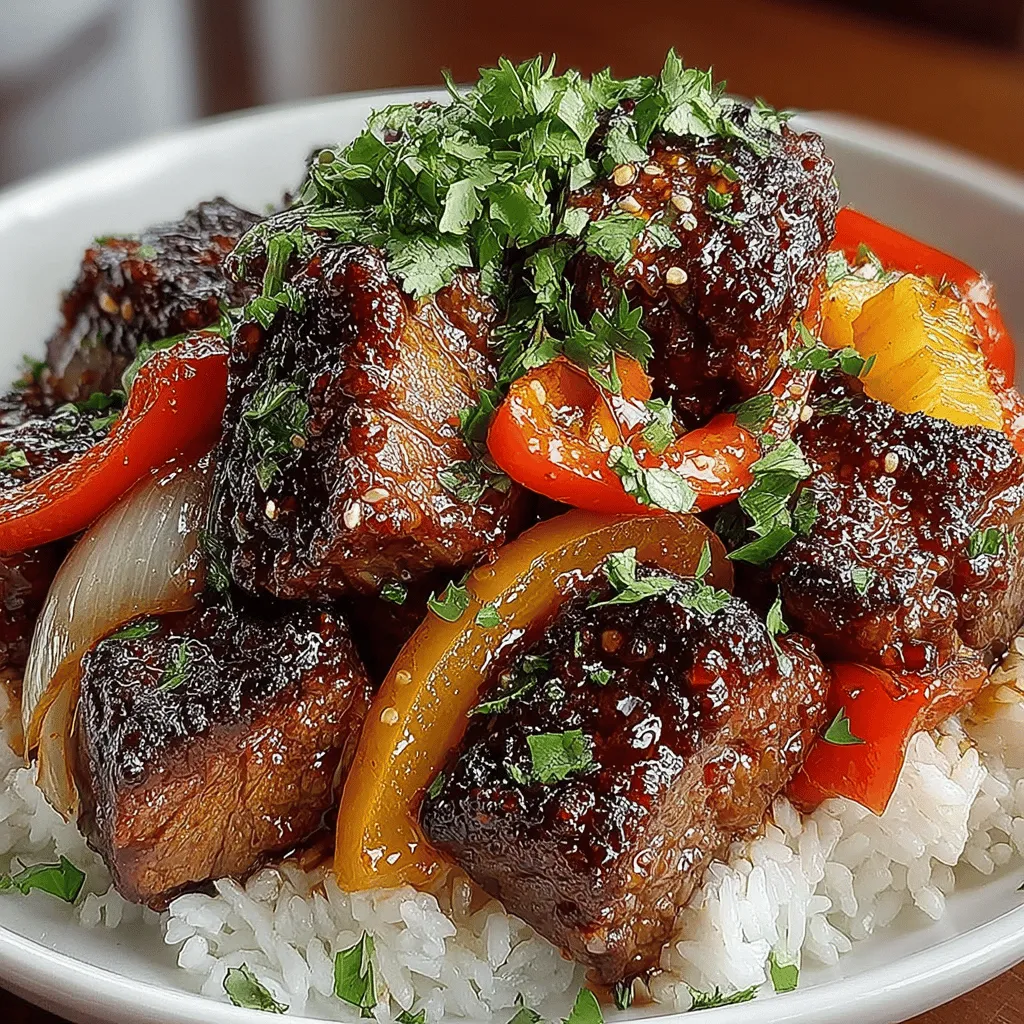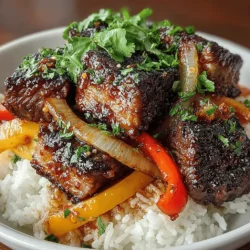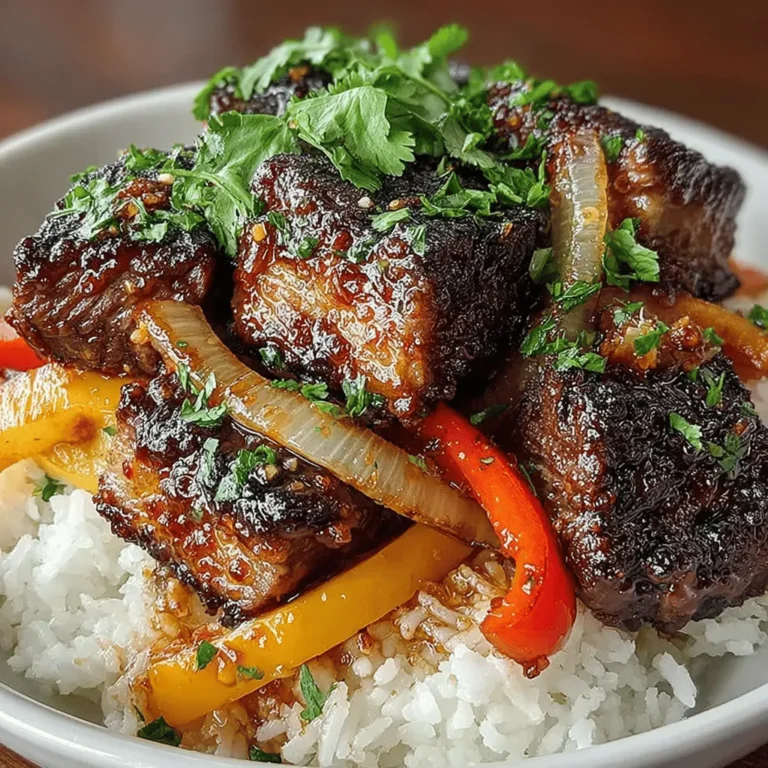Tropical Pineapple Glazed Beef: A Culinary Journey to the Tropics
Tropical Pineapple Glazed Beef is a delightful dish that brings the vibrant flavors of the tropics right to your kitchen. This recipe is inspired by the lush landscapes and culinary traditions of tropical regions, where fresh fruits and bold spices come together to create unforgettable meals. The star of this dish is undoubtedly the pineapple glaze, which beautifully complements tender beef sirloin, creating a harmonious blend of sweet, savory, and umami flavors. If you’re looking to impress your family or guests with an exotic twist on a classic beef dish, this recipe is sure to be a hit.
One of the standout features of Tropical Pineapple Glazed Beef is its unique flavor profile. The glaze combines the natural sweetness of fresh pineapple juice with the salty richness of soy sauce and the depth of garlic and ginger. This fusion not only tantalizes your taste buds but also highlights the versatility of beef as a canvas for various flavors. Moreover, the inclusion of vibrant bell peppers adds both color and nutrition, making this dish not just a feast for the palate but also for the eyes.
Understanding the Ingredients
To create the perfect Tropical Pineapple Glazed Beef, it’s essential to understand the ingredients that contribute to its deliciousness. Each component plays a crucial role in building flavor and enhancing the overall dish.
Beef Sirloin
The foundation of this recipe is beef sirloin, a cut known for its tenderness and rich flavor. When selecting beef, quality is paramount. Opt for grass-fed or organic beef if possible, as it tends to have a better flavor profile and nutritional value. Sirloin is a popular choice for grilling or stir-frying, as it cooks quickly and remains juicy when prepared correctly. For this recipe, slicing the beef against the grain will help ensure each bite is tender and easy to chew.
Fresh Pineapple Juice
Fresh pineapple juice is the star of the glaze, offering a burst of tropical flavor and natural sweetness. Beyond taste, pineapple juice is rich in vitamins C and B6, as well as manganese, which is essential for bone health and metabolism. Additionally, it contains bromelain, an enzyme that helps break down proteins, making it an excellent tenderizer for the beef. The bright acidity of the juice not only balances the richness of the beef but also enhances the overall flavor of the dish.
Soy Sauce
Soy sauce is a staple in many Asian dishes and serves multiple purposes in this recipe. It acts as a marinade, infusing the beef with a savory depth that complements the sweetness of the pineapple glaze. The umami flavor derived from soy sauce enhances the overall taste, making every bite more satisfying. For those watching their sodium intake, low-sodium soy sauce can be substituted without sacrificing flavor.
Brown Sugar
To balance the savory and sweet elements, brown sugar is added to the glaze. This ingredient not only contributes sweetness but also adds a hint of molasses flavor, which enhances the complexity of the dish. The sugar caramelizes during cooking, creating a beautiful glaze that coats the beef and vegetables, providing a sticky and satisfying texture.
Garlic and Ginger
No tropical dish would be complete without the aromatic qualities of garlic and ginger. Both ingredients are essential for adding depth and warmth to the glaze. Garlic offers a robust, savory flavor, while ginger provides a zingy freshness that brightens the overall profile of the dish. Together, they create a fragrant base that elevates the beef and complements the fruity notes of the glaze.
Vegetables
No meal is complete without a variety of colorful vegetables, and this recipe includes red and yellow bell peppers and onions.
– Red and Yellow Bell Peppers: These vibrant vegetables not only add visual appeal but also boast a wealth of nutrients. They are rich in vitamins A and C, which support immune function and skin health. Additionally, their natural sweetness pairs beautifully with the savory glaze, adding layers of flavor and texture.
– Onion: Onions enhance the flavor base of the dish, providing a subtle sweetness when sautéed. They also contribute to the overall texture of the dish, adding a satisfying crunch that contrasts with the tender beef.
The Marination Process
Marinating the beef is a crucial step in this recipe, as it allows the flavors to penetrate the meat, enhancing both taste and tenderness. The marination process not only infuses the beef with the tropical flavors of the pineapple glaze but also helps to break down any tough fibers, resulting in a more enjoyable eating experience.
To create the marinade, start by combining fresh pineapple juice, soy sauce, brown sugar, minced garlic, and grated ginger in a mixing bowl. Whisk these ingredients together until the sugar is dissolved and the mixture is well combined.
1. Prepare the Beef: Slice the beef sirloin into thin strips, about 1/4 inch thick. This will help the marinade penetrate the meat more effectively and ensure even cooking.
2. Combine and Marinate: Add the sliced beef to the marinade, ensuring that each piece is thoroughly coated. Cover the bowl with plastic wrap or transfer the mixture to a resealable plastic bag for easier handling. Allow the beef to marinate in the refrigerator for at least 30 minutes, but ideally for 1 to 2 hours. For the best results, marinate overnight to maximize flavor absorption.
3. Tips for Marinating Duration: While a short marination time can enhance flavor, longer marination allows for deeper penetration of the marinade. However, avoid marinating for more than 24 hours, as the acidity of the pineapple juice can begin to break down the meat too much, resulting in a mushy texture.
Preparing the Vegetables
While the beef is marinating, it’s time to prepare the vegetables. Proper vegetable preparation is key to ensuring they cook evenly and maintain their crispness during the sautéing process.
1. Cutting the Vegetables: Begin by washing the red and yellow bell peppers and the onion. Remove the stems and seeds from the bell peppers, then slice them into thin strips. For the onion, halve it and slice it into thin half-moons. Aim for uniform sizes to ensure even cooking.
2. Storing Vegetables: If you’re not cooking the vegetables immediately, store them in an airtight container in the refrigerator to keep them fresh. You can also prep them a day in advance to save time on the cooking day.
3. Timing for Sautéing: Proper timing is essential to retain the vegetables’ crispness. Start sautéing the onions first, as they take slightly longer to soften. Once they are translucent, add the bell peppers and stir-fry for another 3-5 minutes, or until they are tender yet still crisp. This method not only enhances the flavor but also keeps the vibrant colors intact, making your dish visually appealing.
As you embark on this culinary adventure with Tropical Pineapple Glazed Beef, remember that each step is an opportunity to enhance the flavors and textures that make this dish truly special. Stay tuned for the next part of this article, where we will explore the cooking process and how to bring all these vibrant ingredients together for a delicious meal.

Cooking Techniques
Sautéing vs. Stir-frying: Choosing the Right Method for This Recipe
When preparing Tropical Pineapple Glazed Beef, selecting the appropriate cooking technique is crucial for achieving that perfect balance of flavor and texture. Sautéing involves cooking food quickly in a small amount of oil over relatively high heat, while stir-frying is a faster method that typically uses higher heat and requires constant stirring. For this recipe, sautéing is preferred as it allows for more control over the cooking process and ensures that the beef becomes tender while allowing the vegetables to retain their crispness.
Optimal Heat Settings for Cooking Beef and Vegetables
To achieve the best results, use medium-high heat when sautéing the beef. This temperature allows the beef to sear beautifully, enhancing its flavor and locking in juices. Once the beef is cooked to your liking (medium-rare to medium is ideal), it’s time to add the vegetables. Reduce the heat slightly to medium to prevent the vegetables from burning while still allowing them to cook through and maintain their vibrant color and crunch.
Importance of Skillet Choice for Even Cooking
The choice of skillet can significantly impact the final outcome of your dish. A heavy-bottomed skillet or a cast-iron pan is highly recommended for this recipe. These types of pans distribute heat evenly, preventing hotspots that could lead to uneven cooking. Additionally, they can withstand higher temperatures, which is essential for achieving that desirable sear on the beef.
Creating the Pineapple Glaze
Detailed Explanation of How to Make the Glaze from the Marinade
The pineapple glaze is the star of this dish, adding a sweet and tangy flavor that perfectly complements the savory notes of the beef. To create the glaze, start by reserving a portion of the marinade used for soaking the beef. Strain this marinade to remove any solid bits, then transfer it to a small saucepan. Bring the marinade to a gentle boil over medium heat, allowing it to reduce by half. This process intensifies the flavors and creates a more concentrated glaze.
Role of Cornstarch in Achieving the Desired Consistency
To thicken the glaze to the perfect consistency, you will need cornstarch. In a separate bowl, mix one tablespoon of cornstarch with an equal amount of cold water to create a slurry. Gradually add this mixture to the boiling marinade, stirring continuously. The cornstarch will activate and thicken the glaze, giving it that luscious, glossy appearance. For an even richer flavor, consider adding a splash of soy sauce or a hint of lime juice to the glaze just before serving.
Tips for Ensuring a Balanced Flavor in the Glaze
Achieving a well-balanced glaze is key to elevating the dish. Taste the glaze after it has thickened and adjust as necessary. If it’s too sweet, add a splash of vinegar or lime juice for acidity. If it’s too tangy, a touch of honey or brown sugar can help round out the flavors. Remember that the glaze will also blend with the sautéed beef and vegetables, so aim for a flavor that can hold its own yet complements the other ingredients.
Combining Flavors
Importance of Integrating the Sautéed Vegetables with the Glazed Beef
Once your beef is perfectly sautéed and the glaze is ready, it’s time to bring everything together. The integration of sautéed vegetables with the glazed beef is essential for creating a cohesive dish. Pour the thickened glaze over the beef in the skillet, then gently fold in the vegetables. This step ensures that every bite is packed with flavor, and the sauce not only coats the beef but also clings to the vegetables.
How to Properly Mix Without Compromising Texture
To maintain the integrity of the beef and vegetables, use a spatula or wooden spoon to gently toss them together, being careful not to break the pieces apart. The goal is to evenly distribute the glaze while ensuring the vegetables remain crisp and the beef stays juicy. This careful mixing preserves the texture, allowing guests to enjoy the delightful contrast between tender beef and crunchy vegetables.
Serving Suggestions
Presentation Ideas for the Dish
When it comes to serving Tropical Pineapple Glazed Beef, presentation is key. Start by placing a generous serving of jasmine rice on each plate, creating a base for the beef and vegetables. Spoon the glazed beef and vegetables over the rice, allowing the sauce to cascade down the sides. For added visual appeal, consider garnishing the dish with fresh cilantro leaves, which not only brighten the presentation but also enhance the overall flavor profile.
Complementary Side Dishes
While Tropical Pineapple Glazed Beef is a star dish on its own, it pairs beautifully with a variety of side dishes. A simple cucumber salad drizzled with rice vinegar can provide a refreshing contrast to the rich flavors of the beef. Additionally, stir-fried greens such as bok choy or spinach can add a nutritious element while complementing the tropical theme. For a heartier option, consider serving it alongside coconut rice, which enhances the dish’s tropical essence.
Garnishing Techniques with Fresh Cilantro
Garnishing is an art that can elevate your dish from ordinary to extraordinary. Fresh cilantro not only adds a pop of color but also a burst of freshness. To garnish, sprinkle finely chopped cilantro over the plated beef and vegetables just before serving. For an extra touch, consider adding thinly sliced red chili for a hint of heat or toasted sesame seeds for added crunch. These finishing touches can make your dish visually appealing and tantalizing to the taste buds.
Nutritional Overview
Caloric Breakdown of the Dish per Serving
When considering the nutritional aspects of Tropical Pineapple Glazed Beef, it’s essential to understand its caloric content. A serving typically contains approximately 450 calories, depending on the specific cuts of beef and the amount of sauce used. The dish provides a balanced mix of protein from the beef, carbohydrates from the rice, and vitamins from the vegetables.
Health Benefits of the Ingredients Used
This recipe not only delights the palate but also offers several health benefits. Pineapple is rich in vitamins C and B6, as well as manganese, which are vital for immune function and metabolic health. The bell peppers and onions add fiber and essential nutrients, promoting digestive health. Additionally, lean cuts of beef can provide high-quality protein, essential for muscle repair and growth.
Potential Dietary Adjustments or Substitutions for Different Preferences
For those with dietary restrictions or preferences, this recipe can be easily adapted. To make it gluten-free, ensure that the soy sauce is gluten-free or substitute with tamari. Vegetarians can replace the beef with tofu or tempeh, marinating it in the same pineapple marinade to impart flavor. For a lighter version, consider using chicken or turkey instead of beef, or even a combination of vegetables for a plant-based delight.
Conclusion
Tropical Pineapple Glazed Beef is more than just a meal; it’s an experience that brings a burst of tropical flavors to your dining table. The dish’s appeal lies in its harmonious balance of sweet and savory, making it a versatile choice for family dinners, festive gatherings, or casual entertaining. By exploring the vibrant flavors of this recipe, you can take your culinary skills to new heights.
Encourage your family and friends to embrace tropical flavors in their cooking, and don’t hesitate to experiment with the ingredients to make this dish your own. Whether you’re enjoying it as a weeknight dinner or showcasing it at a gathering, Tropical Pineapple Glazed Beef is sure to impress and satisfy. So gather your ingredients, fire up the skillet, and embark on a delicious culinary adventure that transports you straight to a tropical paradise.


